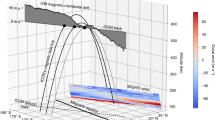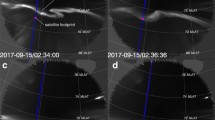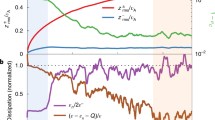Abstract
In the auroral zone, ionospheric plasma often moves horizontally at more than 1 km s−1, driven by magnetospheric electric fields, but it has usually been assumed that vertical velocities are much smaller. On occasions, however, plasma has been seen to move upwards along the magnetic field line at several hundred m s−1. These upward velocities are associated with electric fields strong enough to heat the ion population and drive it into a non-thermal state1,2. Here we report observations of substantial upwards acceleration of plasma, to velocities as high as 500 m s−1. An initial upthrust was provided by a combined upwelling of the neutral atmosphere and ionosphere but the continued acceleration at greater heights is explained by a combination of enhanced plasma pressure and the 'hydrodynamic mirror force'3. This acceleration marks an important stage in the transport of plasma from the ionosphere into the magnetosphere.
This is a preview of subscription content, access via your institution
Access options
Subscribe to this journal
Receive 51 print issues and online access
$199.00 per year
only $3.90 per issue
Buy this article
- Purchase on Springer Link
- Instant access to full article PDF
Prices may be subject to local taxes which are calculated during checkout
Similar content being viewed by others
References
St.-Maurice, J.-P. & Schunk, R. W. Rev. Geophys. Sp. Phys. 17, 99–134 (1979).
Lockwood, M. et al. Geophys. Res. Lett. 14, 111–114 (1987).
Suvanto, K., Lockwood, M. & Fuller-Rowell, T. G. J. geophys. Res. (in the press).
Folkestad, K., Hagfors, T. & Westerlund, S. Radio Sci. 18, 867–879 (1983).
Winser, K. J., Jones, G. O. L. & Williams, P. J. S. Physica Scripta 37, 640–644 (1988).
Winser, K. J., Jones, G. O. L. & Williams, P. J. S. J. atmos. terr. Phys. 50, 379–382 (1988).
Jones, G. O. L., Winser, K. J. & Williams, P. J. S. J. atmos. terr. Phys. 48, 887–892 (1986).
Smith, R. W., Winser, K. J., van Eyken, A. P., Quegan, S. & Allen, B. T. J. atmos. terr. Phys. 47, 489–495 (1985).
Lockwood, M. Adv. Sp. Res. 6, 63–77 (1982).
Winser, K. J., Jones, G. O. L. & Williams, P. J. S. J. atmos. terr. Phys. 48, 893–904 (1986).
Winser, K. J., Farmer, A., Rees, D. & Aruliah, A. J. atmos. terr. Phys. 50, 369–377 (1988).
Burnside, R. G., Tepley, C. A. & Wickwar, V. B. Ann. Geophys. 5A, 343–349 (1987).
Hedin, A. J. geophys. Res. 92, 4649–4662 (1987).
Author information
Authors and Affiliations
Rights and permissions
About this article
Cite this article
Jones, G., Williams, P., Winser, K. et al. Large plasma velocities along the magnetic field line in the auroral zone. Nature 336, 231–232 (1988). https://doi.org/10.1038/336231a0
Received:
Accepted:
Published:
Issue Date:
DOI: https://doi.org/10.1038/336231a0
This article is cited by
-
3DI: A novel ion composition and three-dimensional velocity analyzer for the topside ionosphere
Scientific Reports (2020)
-
Satellite Experiments Simultaneous with Antarctic Measurements (SESAME)
Space Science Reviews (1995)
Comments
By submitting a comment you agree to abide by our Terms and Community Guidelines. If you find something abusive or that does not comply with our terms or guidelines please flag it as inappropriate.



